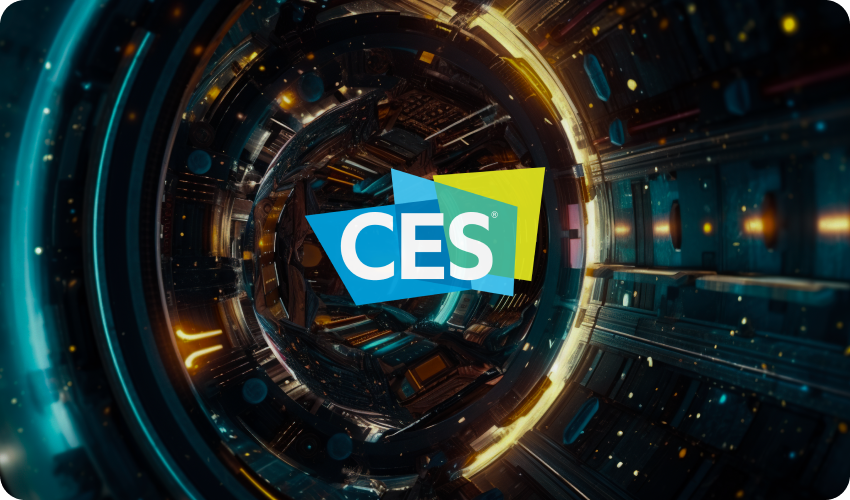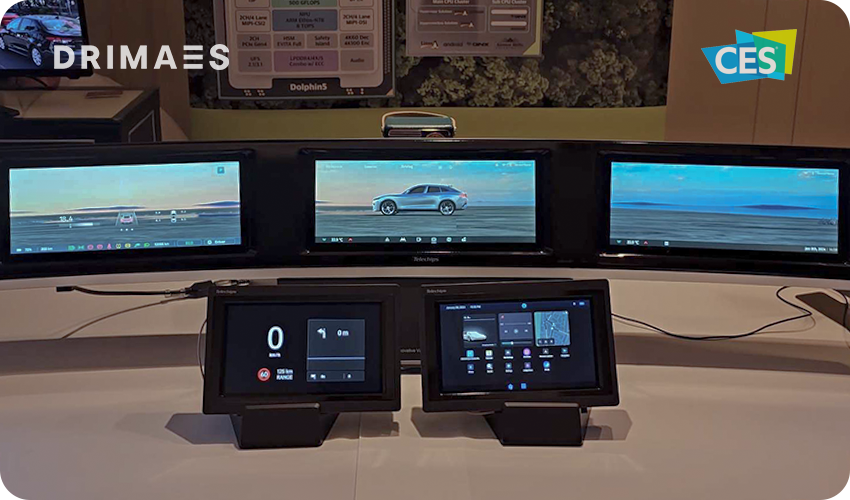
[EVENT] CES 2024 DRIMAES Report
Jan 18, 2024 | SEOUL
DRIMAES product mentioned within the articles are offered by DRIMAES, Inc.
Editor’s Comment:
CES 2024 successfully concluded, and one of the most prominent trends was the rapid development of the mobility ecosystem and Software-Defined Vehicles (SDVs) in the era of advanced AI. Particularly in the automotive industry, the significance of software has never been more emphasized, attracting the attention of many corporate executives and consumers. The fusion of mobility and advanced technology, along with the accelerated co-work between automotive and other industries, provided an interesting perspective on how the future of mobility will dramatically transform. Here’s a glimpse into DRIMAES’ second presence at CES 2024.
Chapter 1.
Let’s Plug-in, DRIMAES at CES
DRIMAES’ 2nd CES showcased more sophisticated solutions, offering a deeper and broader connected experience. The exhibit was a collaboration with Qualcomm and Telechips, DRIMAES’ official business partners. The two key solutions, which will influence tomorrow’s mobility ecosystem, garnered much attention at CES.
[1] Fleet Management Solution: ACCESS

ACCESS, DRIMAES’ fleet management platform, is a cloud-based solution utilizing Qualcomm’s ‘Snapdragon’ ecosystem. It minimizes data management overhead by supplying an API set based on various user and sensor data collected from vehicles, effectively connecting to various connectivity services. ACCESS enables a new value in the user journey with efficient maintenance and various additional services.

Especially when partnered with enterprises and vehicle service providers, ACCESS’s characteristics are maximized. The solution maintains vehicles in the latest state, streamlining vehicle and operational efficiency. Despite its scalability, DRIMAES continuously strives to build a robust and flexible platform to actively embrace the growing service ecosystem. The platform allows real-time monitoring and management of each vehicle’s driving status, as demonstrated at the exhibit.
[2] Integrated In-Vehicle Infotainment Solution based on One-Chip
A hidden gem of DRIMAES’ exhibit, in collaboration with global fabless semiconductor company Telechips, was the one-chip-based in-vehicle infotainment solution. DRIMAES showcased a differentiated mobility UX by deploying its container-based web platform on Telechips’ next-generation cockpit application processor (AP) ‘Dolphin5’. The integrated infotainment solution, capable of running various operating systems, was demonstrated with Android environment, running a web browser and DRIMAES’ third-party service apps.
>> Key Services and Partnerships <<
Snapp Automotive
A German automotive software development company specializing in designing its OS and UI/UX based on Android Automotive OS (AAOS). Collaborating with major European carmakers, Snapp Automotive’s operating system was ported onto DRIMAES’ container virtualization technology, showcasing a versatile solution.
YPER
Focusing on car care, YPER offers convenient car wash and maintenance reservation services within the infotainment system. It provides driver-centric vehicle management services, including delivery hand car wash and self-service car wash reservation systems.
Pick!
An AI-based news solution for vehicles, developed jointly by DRIMAES, NCSOFT, and Yonhap News. Pick! uses NCSOFT’s LLM-based AI solution to provide personalized news content in real-time voice news format, allowing drivers to stay focused on the road.
Chapter 2.
Twist Ground and Aero
The exhibit not only highlighted groundbreaking changes in ground mobility but also showcased extensive innovations, from diversified ground mobility to aerial mobility. This included participation from traditional car makers, new startups, and tech companies from various industries, exploring new possibilities in mobility.
>> Key Exhibitions and Projects <<

HD Hyundai | ‘Xite Transformation
HD Hyundai’s ‘Xite-Transformation’ project, showcased at CES 2024, received significant attention for its innovative shift, marked by the impressive presence of smart heavy equipment on display. The project aims to address a variety of human challenges, including safety, security, supply chain issues, and climate change, utilizing technologies like artificial intelligence and digital twins.
The core concept of the project focuses on solving the shortage of equipment operators and commercial drivers, and enhancing productivity through the realization of autonomous work sites. The concept excavator displayed, using electric propulsion, features electric motors and actuators for the main arm operation. Innovations like making the construction equipment’s bucket transparent are expected to significantly contribute to safety and efficiency on future construction sites.
B-ON | EV Truck ‘Pelkan’
B-ON, an American electric vehicle startup, mainly provides comprehensive services for electric vehicle transition. Their ‘Pelkan,’ a compact electric truck introduced at CES, was designed for urban last-mile logistics, showcasing efficiency and novelty.
A notable feature, the ‘Smart Dispenser,’ caught our attention. It scans the shipping address on the cargo box when loaded onto the truck and rearranges the shelf layout automatically upon arrival at the destination, using GPS information. This feature significantly increases the delivery driver’s efficiency by eliminating the need to individually sort and stack parcels. B-ON’s exhibit demonstrated the synergy expected when vehicle efficiency is combined with an integrated management platform.
SK | Future Aerial Mobility
SK Group made headlines at CES 2024 with ‘SK Wonderland,’ an interactive theme park. Among its highlights was the ‘Magic Carpet Ride’ project. Along with Hyundai’s unveiled UAM model ‘Supernal,’ SK also showcased a flying vehicle equipped with an AI processor.
The ‘Magic Carpet Ride’ represents urban aerial mobility (UAM) technology. The flying vehicle, equipped with an AI processor developed by SK’s subsidiary ‘SAPEON,’ detects and analyzes safety elements during flight. This reflects SK’s vision of addressing major global issues like climate change through technology applications like ‘eco-friendly’ and ‘net-zero.’ SK’s commitment to sustainability and supporting technology was impressively demonstrated.
Xpeng | Flying Car
Xpeng, a Chinese electric vehicle manufacturer, unveiled its first real-life flying car at CES 2024, a scene reminiscent of childhood TV fantasies. Developed by its subsidiary Xpeng AeroHT, the flying car appears as a regular sports car but transforms into an ‘eVTOL Flying Car’ at the push of a button.
Xpeng Aero HT plans to mass-produce these flying cars, including the ‘Land Aircraft Carrier,’ a modular ‘flying car.’ The technology combines electric vehicles (EV) and eVTOL, with the ground module (BEV) accommodating 4–5 passengers and the air module (eVTOL) being a fully electric piloted aircraft capable of vertical take-off and landing, and low-altitude flight. The exhibit allowed firsthand experience of the new transportation solutions resulting from the fusion of automotive and aviation technologies.
Hyundai Motors | DICE
Hyundai Motor’s ‘DICE,’ presented for the first time at CES 2024, is a personal mobility vehicle centered around the concept of ‘Digital Curated Experience.’ This technology, based on spatial computing, prioritizes the user to provide optimized services, showcasing a new approach to user experience (UX) in line with Hyundai’s vision of ‘human-centered life innovation.’
DICE offers personalized services based on AI, with a three-sided internal display providing an immersive travel experience. The ‘Ringpad,’ a face-to-face interface, facilitates communication with AI, and the personal device integration suggests customized journeys focused on the travel environment, even in vehicles not personally owned. While specific details were limited, the project impressively reflected Hyundai’s future-oriented vision and focus on ‘space.’
Chapter 3.
Redefine the future mobility
In summary, CES 2024 focused on the future shaped by the combination of mobility and SDVs. SDVs signify cars evolving from mere transportation to platforms that are continuously updated and improved through software. This shift not only dramatically improves vehicle performance, safety, and user experience but also creates new services and business models through integration with various industries. The next phase involves redefining and tailoring our approach to fit our purposes and applications. While changes in vehicle appearance were noted, the emphasis was on combining established spaces and technologies to amplify new content values.
At CES 2024, DRIMAES highlighted two future-focused exhibits that are particularly promising in terms of their application and potential impact:
[1] AUO: Automotive Display Use-cases

How can content be utilized effectively? AUO provides a great example with its display capabilities. This Taiwan-based automotive display specialist utilized the driver’s windshield, where the driver’s gaze is most often focused. They demonstrated that vehicle interiors are evolving beyond simple information displays, moving towards interactive, user-centric content. This technology can offer a richer, more personalized experience for both drivers and passengers.
Notably, AUO’s ‘Interactive Transparent Window’ feature showcased the potential for content expansion. By integrating a transparent micro LED display into the vehicle’s side windows, AUO created new surfaces for displaying content. This technology allows for diverse touch functions, including entertainment, online video conferencing, and displaying safety warning information. AUO’s use of HUD (Head-Up Display) was also impressive. They proposed a ‘more is better’ approach for HUDs, which have significant needs but have been underutilized due to competition with other center displays.
The photo shows three large HUD areas, a design that allows for smooth screen transitions and a larger display area, increasing the detail and utility of the information shown. Although its application in actual vehicles is still undecided, it raises the possibility of future vehicles distributing content through existing glass surfaces, potentially leading to cars without traditional displays.
[2] KIA: PBV Modular Concept
Following the theme of display utilization, let’s introduce Kia’s ‘purpose and context’ centered mobility. The birth of purpose-based mobility solutions may create new value. Kia’s PBV modular concept refers to a modular vehicle design that can be reconfigured according to user needs, opening up the vehicle for more purpose-oriented and diverse uses.
Kia’s ‘PV’ concept is part of the ‘Platform Beyond Vehicle’ (PBV) strategy, aimed at providing electric vehicles customized for various purposes. This strategy is Kia’s effort to offer modular, purpose-specific electric vehicles for both business and personal users. The first dedicated PBV model, ‘PV5 Concept,’ is a mid-sized model developed considering scalability for various logistics-focused businesses, such as urban passenger and cargo transportation.
Kia plans to expand the PV concept through three stages of the PBV strategy. Starting with optimization for key areas like ride-hailing, delivery, and utilities, moving to complete a dedicated PBV model lineup, and ultimately progressing to an AI-based customized mobility platform. This strategy marks a significant shift from the traditional concept of automobiles, aiming to provide optimized vehicles and services that meet the unmet needs of diverse customers and communities.
Next Journey Begins
CES 2024 marked an exciting beginning for the journey of innovation in mobility, demonstrating the immense potential of these innovations to fundamentally change our lifestyles and urban landscapes. DRIMAES looks forward to participating in this evolving journey.










